Whether too low or too high, indoor humidity can cause a variety of problems. When indoor humidity levels are low, human health may suffer. Dry, itchy skin, brittle hair, nasal and bronchial irritation, and shocks from static electricity are symptoms of low humidity levels. For maximum indoor com fort the Consumer Products Safety Commission suggests that the indoor humidity level be maintained at between 30 and 50 percent at 72 degrees Fahrenheit (22 degrees Celsius).
High indoor humidity is not a problem in drafty older houses, where humidity escapes through cracks around leaking doors and windows, and through walls and ceilings that contain no insulation or vapor retarder. Outdoor relative humidity averages much lower in sea Sons of cold weather and may go down to the 15 percent level, which is as dry as the Sahara Desert. In winter, it's often necessary to use a humidifier to maintain humidity at minimum com fort levels of between 30 and 50 percent.
As the emphasis on energy conservation has increased, building codes have become more strict, calling for increased levels of insulation and the use of continuous vapor retarders, meaning vapor retarders in both walls and ceilings. To control vapor and heat loss, windows and doors have been engineered to increase their thermal performance, and to decrease the air infiltration rate.
To improve their thermal efficiency, many older houses have been retrofitted with improved weather-stripping, caulk, and insulation. This emphasis on better thermal efficiency has tightened houses against moisture migration to the point that the effect on occupants is somewhat comparable to living inside a plastic bag.
Many new houses don't require humidifiers; in fact, in many newer houses indoor humidity levels are too high for comfort. These higher humidity levels pro duce myriad problems, including mold, mildew, peeling paint, and damage to the house structure and furnishings.
In this section we will discuss both high and low humidity levels, and suggest ways to control indoor humidity levels, both to minimize damage to the house structure and to maintain maximum occupant comfort.
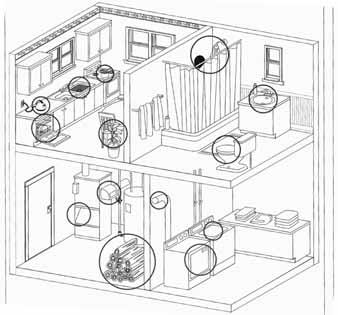
Home Moisture Sources: Home humidity is raised by cooking,
bath activities, stored firewood, heating equipment, laundry, and potted
plants.
HIGH INDOOR HUMIDITY
High indoor humidity levels can produce damage to all the components of a house, including window sashes, doors, trim, and wood framing. Too much humidity can virtually destroy the house itself. If you suspect that you may have high humidity levels, use the following list to carefully assess the entire house for symptoms of excess indoor humidity.
Symptoms of High Humidity
Dampness When indoor humidity is too high, there often is a pervasive feeling of dampness in the house, especially in closets, stored clothing, or furniture. Depending on the indoor ventilation and window quality at humidity levels above 40 percent, condensation or buildup of frost or ice on window glass may develop. To compromise between frost on window panes and personal comfort, reduce humidity levels to the point where moisture does not condense on window glass.
Odors Other symptoms of moisture buildup include the presence of mold or mildew and musty odors. (See Mildew below.)
Warped Wood When wet, wood trim or siding may expand and deform, then crack or warp during dry weather. Dark brown, black, or green stains indicate mildew, while gray or yellow stains with web-like lines indicate moisture-borne fungi. These symptoms may be found on either wet or dry wood, or beneath car pets, behind furniture, or on concrete foundations.
Wood Rot/Decay Knock on wood: sound wood will have a sharp ring, while soft wood will yield a dull thud when struck. Wood that's rotted by moisture will usually be soft and easy to penetrate with a sharp tool. Use a sharp carpenter’s awl or ice pick to probe wood framing. Probe any wood that looks suspicious, with emphasis on the mud sills (the flat wood member that meets the top of the foundation wall), the rim or band joists that sit atop the mud sills, and all the floor joists, particularly at the point where the floor joists meet the rim joists. The sharp probe will easily penetrate any decayed or rotted wood, while wood that's sound will resist penetration.
Plumbing Check the entire plumbing system for leaks or dripping faucets (see Section 8, Leaking Plumbing). If humidity levels are too high, vapor may condense on cold-water supply pipes or on the toilet bowl.
New Construction During new construction, hundreds of gallons (liters) of water may be used in a house interior. This water is contained in concrete, drywall materials, and paint, among other things. A single kiln-dried 2 x 4 stud may contain 1 cup (250 milliliters) of water, so there is a huge amount of water contained in the framing lumber.
During the settling period, all the interior moisture will escape into the air and exit the structure. To avoid moisture and shrink age problems, the best time to build your new house is during warm, dry weather. After pouring the concrete basement slab, allow it to cure for at least one week before starting the drywall finishing. This will prevent moisture buildup during the construction period, and you will move into a house that has already exhausted most of the moisture introduced during construction.
Wet Basements Damp or wet basement walls or any other sign of water entry into the building will con tribute to a buildup of excess moisture in the house. (See Waterproofing a Basement.)
Masonry Problems
Efflorescence is a powdery, white to gray substance that may leach out of concrete when moisture is present. Chipped or crumbling concrete and /or a buildup of efflorescence on basement walls usually indicates the presence of moisture.
Evaporation Evaporative moisture is added to the house interior when standing water evaporates from house plants, aquariums, sewer drains, drainage sumps, or toilet bowls that are left uncovered. Keep covers in place over drains or sumps, and leave the lid down on the toilet bowl.
Appliances Gas-fired heating, water-heating, and cooking appliances produce water vapor during the combustion process. This moisture production is increased when the appliances are not properly cleaned and adjusted. Unvented kerosene heaters also produce moisture during combustion, and fire wood can give off moisture both during indoor storage and during combustion.
It is a poor idea to vent a clothes dryer into the basement or other laundry area. This practice was a common one generated during the oil embargo to conserve energy use. But a clothes dryer is run sporadically and only a few hours per week, so the heat saved is a very minor gain. In an effort to conserve this small amount of heat, gallons (liters) of water are released from electric or gas dryers into the house. In addition to moisture, gas dryers also vent dangerous combustion gases into the house. Both types of dryers emit lint and chemicals such as bleach and detergents. Vent any clothes dryer, either gas or electric, to the outside. Basement laundry rooms should also be equipped with an exhaust vent of at least 50 cubic feet per minute (4 cubic meters).
Lack of Ventilation Most of the moisture produced by family activities is generated in the kitchen, the bath, and the laundry. Therefore, exhaust fans and vents should be installed in each of these areas. Gas ranges may be unvented, so they give off moisture into the living space. Even though a range hood may be present, there may be no vapor exhaust to the exterior. Some range hood vents are char coal filters that only catch grease and filter air, and don't exhaust moisture to the outdoors. Other range vent hoods are exhausted into the attic, where the moisture and grease may be trapped, causing a variety of problems. Correct venting so it exhausts moisture out side, not into the attic. The exhaust vents should have the capacity to move a mini mum of 100 cubic feet of air per minute (cfm) in the kitchen, and 50 cfm in the bathroom or laundry.
Vapor Retarder In houses that have no vapor retarder, or a poorly installed vapor retarder, moisture can pass through the wall or ceiling either by diffusion or through air leakage or convection. When this occurs, moisture can condense on either ceiling or wall insulation, thus greatly reducing the R-value of the insulation. This moisture can also cause damage to plaster or wall board, promote the growth of mildew or mold, and cause dry rot in the framing. (Dry rot is a misnomer, because dry rot is caused by moisture.) As mentioned in Section 5, Vapor Retarders, you can create a vapor retarder by applying a coat of alkyd sealer or paint to the ceilings and to the interior side of exterior walls.
Insulation Voids Any void in the insulation can be a potential trouble spot for moisture buildup. Especially during the heating season, moisture may be seen as wet spots at the juncture or corner where exterior walls meet the ceiling. This caused by moisture condensation on a cold spot or point where the insulation blankets in the ceiling don't overlap at the top plate of the wall. The remedy is to extend the ceiling insulation so it overlaps the top plate of the wall but does not block the flow of air from the soffits into the attic.
Temperature Differences
Moisture may condense where air movement is restricted by furniture or drapes that are set against exterior walls, or in closets or in rooms that are closed off and unheated. The remedy is to set furniture away from the wall so air can circulate evenly throughout the house. Also, don't close off an unused room. Because of the spillover effect of heat through the uninsulated interior walls, the potential savings in energy costs from closing a room is small. To the extent that the surfaces in the closed-off room are cooled, the potential for condensation and moisture damage is increased.
Indoor Plants Live plants must be watered, and they will in turn release moisture into the air. If you have many plants, they may be contributing to high indoor humidity levels. Five to seven average plants can generate as much as 1 pint (500 milliliters) of water per day.
Greenhouses or sun rooms that are attached to the house can cause problems when many plants produce high moisture levels and may require ventilation or dehumidification. Unless the common wall between the house and greenhouse is protected with a vapor retarder, the vapor from the greenhouse may migrate into the common wall, causing condensation and moisture problems inside the wall.
Exterior Moisture Problems The siding on the house must never be in con tact with the ground, or rain or snow from the ground will enter the siding and cause it to warp or rot.
Shrubs or trees that shade the house may also reduce air circulation over the exterior, so the exterior surfaces stay constantly damp. The dampness will promote the growth of mildew or mold, and will also cause wood rot. Trim trees and shrubs to allow sunlight and air circulation to dry the exterior surfaces. Do not store firewood or other materials against the house where they obstruct air flow and may trap moisture. Inspect the roof and soffit vents and clean them if they are plugged with leaves or other debris to ensure proper circulation.
Peeling Paint High humidity levels can cause paint to peel on either interior or exterior surfaces. Peeling or alligatored paint caused by humidity is common in bathrooms and kitchens. In extreme cases, a vaporizer or humidifier can cause the paint to peel in that room.
When interior humidity levels rise, interior vapor pressure will cause the humidity to attempt to equalize with exterior humidity levels. If there are no vapor retarders, the moisture-laden air will flow through the exterior walls and will peel the paint on the siding. If there are convective air leaks around window and door openings, the moisture will escape around these voids and will peel the trim paint. This peeling trim paint is commonly seen on stucco or brick houses, where the path of least resistance to moisture passage is around the windows and doors. Caulk all cracks around interior trim to seal against moisture.
If the moisture passes through the ceilings into the attic, paint may peel on soffits, fascia boards, or gable ends of the house. (Refer to “Roof Waterproofing”)
Moisture will peel paint at any point where a crack allows water entry. One common point for exterior peeling paint is at the base of porch posts or pillars, where wood posts meet concrete floors. The water will wick up into the unpainted end grain, causing the paint to peel. Use pressure-treated wood for posts or pillars. Seal the ends of the posts before installation, then caulk cracks where post ends meet concrete.
CONTROLLING INTERIOR HUMIDITY LEVELS
Nature will determine exterior humidity levels, but there is much that can be done to control interior humidity levels. Interior moisture levels affect both the structure of the house and the comfort of the occupants, so it's important to try to hold indoor humidity between 30 and 50 percent when the indoor temperature is 72 degrees Fahrenheit (22 degrees Celsius). In this section we will review methods to control interior humidity levels.
MOISTURE SOURCES
To determine if your interior humidity levels are too high (see Symptoms of High Humidity above), thoroughly review all sources of moisture so you can institute appropriate controls.
The first step is to under stand how much moisture is generated by family activities. For example, mopping a 100-square-foot (3-square-meters) floor will add 3 pints (1.5 liters) of water vapor to the interior, while a five-minute shower can contribute ½ pint (250 milliliters) of water to the air. Cooking dinner on a gas range for a family of four can add 1-¼ pints (625 milliliters) daily, and frost- free refrigerators add a pint (500 milliliters) of water per day through the defrost cycle. Burning an unvented kerosene space heater can add 7.6 pints (2 liters) of water per gallon (4 liters) of kerosene burned. In a faulty furnace, combustion exhaust gas backdrafting or spillage can add a whopping 840 gallons (3,360 liters) of water per year. The humidity gain from each of these activities can be controlled or eliminated. For examples of how water-vapor is generated see above.
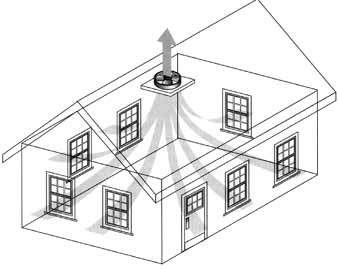
Whole-House Ventilation: A whole-house fan can cool the
house and remove stale/humid air.
WHOLE HOUSE HUMIDITY CONTROL
Humidity problems and remedies vary widely by geographic region. Always contact local building experts and follow standard building practices for your area. Your goal is to move interior humidity so it can equalize with outdoor humidity levels. The advice offered above applies to perhaps three-quarters of the continental U.S. However, if outdoor humidity levels are high, no humidity can transfer from the interior to the exterior. Remember that vapor pressure or humidity transfer is always from the highest level to the lowest level, so if outdoor humidity is a problem, the moisture transfer from venting or exhausting air may be from outdoors in rather than from indoors out. This problem is most common in the states along the southeastern coast of the U.S.
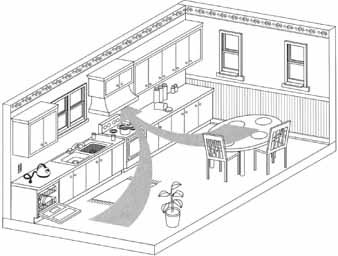
Kitchen ventilation: hood vent in the kitchen exhausts
odors and removes excess moisture.
Appliances
If you have gas-fired appliances, combustion of natural gas can add humidity to the indoors. Be sure that vents are open and that burners are properly adjusted. If combustion air is inadequate, a yellow or wavy flame at the burner can signal incomplete combustion and moisture generation, as well as danger from combustion gases such as carbon monoxide. Each year, at the beginning of the heating sea son, have a professional technician inspect and adjust any gas-fired furnace or water heater. Have your furnace fitted with a duct to supply outdoor air for combustion.
Unvented space heaters can also add to indoor humidity levels. As mentioned, an unvented kerosene heater can add almost 1 gallon (4 liters) of water for each gallon (4 liters) of kerosene burned. In addition, operating any unvented appliance that burns fossil fuel presents a carbon monoxide hazard. Never use any unvented fossil-fuel space heater in the house. Kerosene space heaters present carbon monoxide risks and are therefore too dangerous for use.
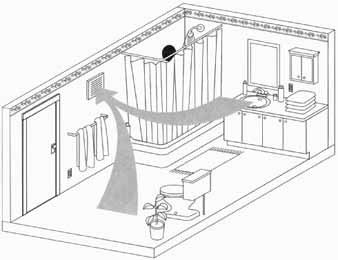
Bath ventilation: The bath is a primary source of humidity.
Install an exhaust fan to remove humidity and prevent moisture damage.
Firewood adds humidity to indoor air during indoor storage and combustion. Buy only well-seasoned firewood, store it outdoors under cover so it can dry out during storage, and close fireplace doors to prevent moisture from entering the living space. Equip wood-burning stoves or fireplaces with outdoor combustion air ducts.
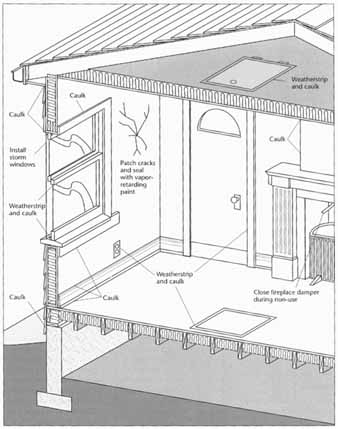
Moisture Transfer: To reduce moisture transfer, reduce
exterior air leaks.
Years ago, gas ranges were exempted from venting code requirements, the theory being that they were operated only occasionally and for limited time periods. Nevertheless, in a tightly built house there is a real danger of carbon monoxide poisoning if an unvented gas range is run for a long period, such as in preparation of a family holiday meal, or to supplement space heating. Never use any gas range for supplemental space heating. Equip the range with a hood exhaust vent that has a capacity to move 100 cubic feet per minute of air (100 cfm or 9 cubic meters), and exhausts the air to the outdoors. When stove filters, use lids to cover cooking utensils and minimize moisture loss into the air.
Plumbing
Plumbing problems can add to indoor humidity levels. Leaking pipes, faucets, or drains all contribute moisture and should he repaired immediately. Inspect and replace faulty drain traps or rusty steel traps under sink drains or tubs. To control evaporation, drainage sumps should have a cover, but many people fail to keep the cover in place. To limit evaporation, cover sumps and floor drains, and keep the toilet seat down.
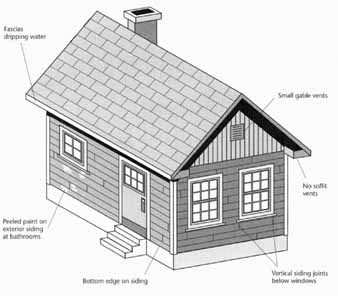
High Humidity: High home humidity can ruin insulation,
peel paint, and rot siding, windows, and house framing.: Fascias dripping
water; Peeled paint on exterior siding at bathrooms; Bottom edge on siding;
Vertical siding joints below windows; No soffit vents; Small gable vents
Another source of interior humidity is condensation on plumbing pipes or fixtures. Buy and install tubular foam insulation for water supply pipes. Condensation, caused by cold water being pumped into the bowl each time the toilet is flushed, is also common on toilet bowls and tanks. This cold water cools the bowl and tank, and warm moist air meeting the cold toilet fixture condenses on its surface. To prevent toilet condensation, cover the fixture with a terrycloth cover, insulate the toilet tank (Styrofoam tank insulation kits are available at home centers), or install a mixing valve that will mix hot and cold water for delivery to the toilet tank. Warm water from the mixing valve will not cool the toilet fixture, so there will be no condensation.
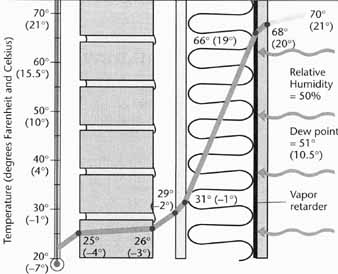
Wall Moisture—Cold Climates: In cold climates moisture
will condense on brick veneer if there is no vapor retarder on the warm
side of the wall.
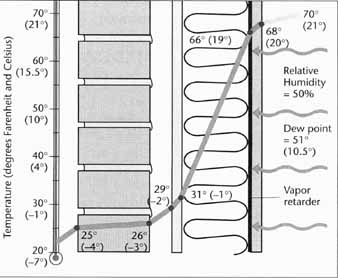
Wall Moisture: Humid Climate: In hot, humid climates
the vapor retarder must be installed on the exterior sheathing.
Potpourri
A tub bath adds only about one-quarter as much moisture to the air as a shower does. Low-flow shower heads control water usage but, because they atomize the water, they add more moisture to the air than ordinary showerheads.
After bathing and drying yourself, use the towel to wipe down the tile or fiber glass shower enclosure, wipe moisture off any shower doors or mirrors, and run the exhaust fan to exhaust the moisture from the bath room. Don’t leave wet towels in a clothes hamper; immediately remove wet towels or bath mats from the bathroom and place them in the clothes dryer so the moisture will be vented outdoors. To improve air flow and reduce humidity, clean air registers and cold air return covers, replace furnace filters monthly, and have air ducts cleaned by professionals at least every two years.
To improve air circulation, install louvered closet doors, wire shelves, and storage baskets in closets.
Desiccants are chemicals that absorb moisture from the air. Nontoxic chemical desiccants, like silica gel or activated alumina, can be placed in any area where moisture is present, such as a damp closet or basement. Place the desiccants in a porous or open container, such as a paper bag. The desiccants mentioned above can be reused; when the material is saturated with moisture, place the desiccant in a 300 degree Fahrenheit (150 degree Celsius) oven for several hours to remove the moisture. Another method to reduce closet humidity is to leave a small light bulb on in the closet.
In climates where low outdoor humidity levels are common, there is no better way to remove moisture from a house than simply opening the windows and letting the house air out. Damp, musty basements often have windows that have not been opened for years, some are even painted shut. Open the windows at opposite ends of the basement and place a fan facing outside at one window. This will promote cross ventilation, and stale, damp basement air will be exhausted.
MILDEW
Mildew is a fungus growth that can produce objection able odors and destroy a house and its contents. Mildew and its source must be addressed, because mildew may be the first signal that more serious problems lurk in the house.
To grow and flourish, mildew spores require heat, darkness, moisture, and poor air circulation. Where there is little air circulation along walls, such as in closets and behind furniture and drapes, check for dark stains that may indicate mildew. These stains often are visible on the walls at corners, or at base trim levels.
To remove mildew, use chlorine bleach (see dilution proportions below) or a disinfectant to kill the spores. Then reduce the humidity levels and permit fresh air to circulate throughout the house. Below are specific tips for removing mildew from interior surfaces and furnishings.
Walls and Ceilings
Mix 1 or 2 cups (250 to 500 milliliters) of chlorine bleach in a gallon (4 liters) of water. Wear eye protection, rubber gloves, and old clothes when handling bleach products, and cover all furniture, drapes, and carpets.
If mildew is widespread, use a sponge to apply the bleach/water mixture to the walls, ceilings, or wood or vinyl floors. Let the solution sit on the surface for a few minutes, then wipe away the mildew spores with a clean cloth and rinse with plain water. If this does not remove the mildew, repeat the procedure, using an additional 1 cup (250 milliliters) of bleach to the mixture. For small areas of mildew, pour the bleach/water solution into a spray bottle and spray the affected area. Use the same bleach/water solution to clean concrete basement walls. If you have a large area to cover, use a sponge mop to apply the solution. Let set a few minutes, then rinse with clear water.
Windows and Doors
Water stains or mildew may form on doors or windows. Some woods such as oak will develop black stains due to the tannic acid in the wood. Try the bleach solution mentioned above on any black stains on doors or windows; if the stains are mildew, the bleach solution will remove them. If not, use oxalic acid to bleach out the stains, following the manufacturer’s instructions.
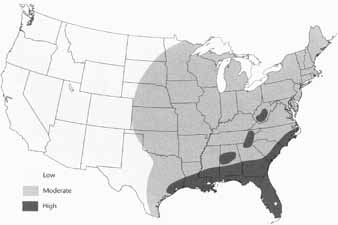
Decay and Rot Areas: High humidity areas are prone to
wood decay, rot, mold, and mildew.
Upholstered Furniture
Move mildewed upholstered furniture or mattresses out doors to air out. Sunlight is best, but may fade furniture colors, so place colored furnishings in the shade for a full day. Vacuum the furniture or mattress thoroughly, then wipe down with a cloth dampened with a 50:50 solution of denatured alcohol and water. Try an inconspicuous spot first. Let the items dry completely. If odors remain, contact a professional fumigating service.
Wood Furniture
Place mildewed wood furniture outside in a shaded area; direct sunlight may cause the wood to warp or split. Remove drawers from dressers or desks. Use a bleach solution to remove the mildew, then rinse. Lightly sand the unfinished portions. When the furniture is completely dry seal and deodorize the bare wood. Mix 1/3 cup (75 milliliters) of cedar oil, (available at furniture stores or drugstores) with 2/3 cup (160 milliliters) of water. Use a small foam paint brush or a clean cloth to apply the cedar oil/water mix to the unfinished wood such as the bottom and insides of drawers.
Clothing, Drapes, and Carpets
To remove mildew, take drapes and clothes to a dry cleaner. For washable clothes or fabrics, hang them in the sunlight and let them air out for a full day, or until odor free. Then wash the clothes as instructed on the labels, using a bleach that's fabric safe. Have carpets and rugs profession ally cleaned.
If a shower curtain is mildewed, soak it in a tub with hot water and chlorine bleach (2 - 3 cups/500 - 700 milliliters) of bleach to tub of water. Plastic curtains can not be damaged by bleach; ensure that curtains made of other fabric can tolerate bleach. After soaking the curtain to kill mildew spores, wash it in the machine and hang it in the sunlight to dry.
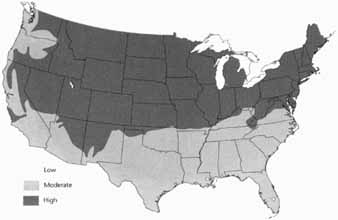 Winter Condensation: Areas north of the lower line are
prone to condensation problems and require vapor retarders.
Winter Condensation: Areas north of the lower line are
prone to condensation problems and require vapor retarders.
Siding, Outdoor Structures
How-to texts often refer to the natural graying of unfinished woods such as cedar or redwood. This gray patina in fact is dirt or mildew. To remove mildew from exterior siding, fences, decks, or retaining walls, mix 1 quart (1 liter) of bleach with 1 gallon (4 liters) of water. Pre wet the wood with clear water, then use a pump-type garden sprayer or paint sprayer to apply the bleach solution to the surfaces. Let sit for five minutes, then use a hose nozzle or power washer to blast away the grime and mildew. Flush all treated surfaces well to remove the bleach. To prevent mildew recurrence, apply a clear wood sealer to the wood when the wood is dry.
The bleach/water solution is inexpensive and is safe for flowers and lawn. If you prefer, there are commercial wood cleaners such as Dekswood that are guaranteed to be environ mentally safe.
DEHUMIDIFYING
In addition to using natural solutions such as ventilation to remove moisture from indoor air, mechanical options are available. These mechanical devices include dehumidifiers, whole-house fans, and air-to-air heat exchangers.
Dehumidifiers
Mechanical dehumidifiers are portable appliances with humidistat switch, that will turn them on when humidity reaches a preset level.
Most dehumidifiers are refrigerator types that cool the air to condense and remove the moisture. The humid air is pulled into the appliance and flows across refrigerator coils. The refrigerator coils are colder than the dew point, so the humidity condenses on the coils and runs down into a catch basin or pan. There is a float shutoff that turns the appliance off when the pan is full. Remove the pan to manually empty the collected water, or attach a hose to the basin so that the collected water flows directly into a floor drain. Dehumidifiers are available in a variety of capacities, and your dealer can help you select the right one for your needs.
Whole-House Fans
Whole-house fans are large fans that are installed in the ceiling at a central point in the house, such as in a center hall ceiling. Whole-house fans will both cool the house interior and also remove indoor humidity, assuming the exterior air is less humid than the interior air and moisture transfer can occur.
The theory behind the whole-house fan is that in all but the warmest climates, outdoor air at night will be cooler than indoor air. The system works best when the lowest windows in the house are opened during cool nighttime hours. Then the fan pulls in the coolest ground-level air and exhausts the warm, stale air from the interior upward into the attic. The warmer air then exits the attic through roof or gable vents, and more cool outside air is pulled in behind it. In this way the entire interior of the house and its contents are cooled to outdoor or ambient temperatures, and excess moisture is removed with the warm air.
To prevent solar heat gain during the heat of the day, at sunrise the fan is shut off and house windows and drapes are closed. Even in hot climates, in a properly insulated house the interior heat rise will be only about 1 degree Fahrenheit (0.5 5° Celsius) per hour, so the house will remain cool throughout the day. In all but the hottest climates this system can be substituted for more expensive air conditioning equipment.
There is much industry confusion regarding the capacity of the fan needed to accomplish whole-house ventilation. According to the American Ventilation Association (AVA), a whole- house fan should have a capacity large enough to achieve one air change per minute. To calculate the fan capacity needed for your house, multiply the square footage of the house by the ceiling height. For example, a house having 1,200 square feet (133 square meters) of floor space x the standard 8-foot (2.5-meter) ceiling height = 9,600 cubic feet (1,060 cubic meters) of air. The whole house fan should thus have a capacity of 9,600 cfm (1,060 square meters per minute).
Air-to-Air Heat Exchangers
Any house that's located in a cold climate, and is tightly built with a continuous (wall and ceiling) vapor barrier, may need an air-to-air heat exchanger. These exchangers have ducts to both the interior and the exterior: the ducts pass each other in the unit and the heat from the exhausted air is transferred to the incoming air, thus conserving energy. Some exchangers don't remove airborne moisture in this process, so be sure to select a unit that meets your needs.
For best performance, an air-to-air heat exchanger should be ducted to all rooms. Because ventilation and air circulation is constant, slightly higher indoor humidity can be tolerated in houses with exchangers.
Small heat exchangers are available as substitutes for exhaust fans in the bath room or kitchen and can be mounted on walls or ceilings.
hwmmp_88.jpg Heat Exchanger: Air-to-air heat exchanger allows stale, moist air to be exhausted while recovering heat; Warmed fresh air in; Warm indoor air in; Cooled indoor air is exhausted; Cool, fresh air; Condensation is removed; Heat is exchanged while air flow is kept separate.
HUMIDIFIERS
If you live in an arid climate, you may need to add indoor humidity to ensure personal comfort. Signs of too-low humidity include shrinkage of wood components such as trim. If this occurs, miter joints at the corners of doors or window trim may open and crack; furniture joints may loosen, and cracks may develop in plaster or wall board. Personal discomfort from low humidity may be due to shocks from static electricity, dry skin, and brittle hair, and nasal or bronchial distress.
Mechanical humidifiers include two basic types: those that are mounted in the ductwork of forced-air heating systems, and separate appliances that can easily be moved about the house.
The type and size of humidifier needed depends on the average relative humidity in your area, plus the size of the space to be humidified. Determine the area of your house in cubic feet (or meters) (length x width x ceiling height) and take this figure to your local dealer. He or she will help you choose the right size humidifier for your needs.
Depending on its capacity, a mechanical humidifier can add up to 20 gallons (80 liters) of water to the home’s interior each day. The aver age humidifier will add about 3 gallons (12 liters) per day. But seven average house plants can add 1 pint (500 milliliters) of water to the air per day; dishwashing, bathing, and cooking can add 4 pints (1 liter) or more per day, and drying clothes indoors can add S to 6 pints (2.5 to 3 liters) per load. The moisture generated by these activities and others, while undesirable in a tightly built house, may add needed humidity to houses in arid climates.